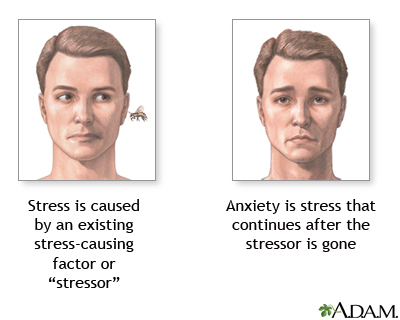Ever been in the middle of a task when all of a sudden your legs start bouncing up and down?
Then, it’s like the feeling travels up.
Your stomach feels uneasy.
Your heart beat changes.
But you can’t discern whether it’s going faster or slower.
The air in your lungs seems to get trapped in your throat.
Then your breathing gets choppy.
When you attempt to adjust your posture, you notice your muscles feel tight.
Then you think: “not this again”
I’m not a proponent for self-diagnosis or the hypochondria induced by googling medical concerns. However, I know the power of awareness. Since I’m a (recovering) overachiever and anxiety runs in my family. I’m no stranger to the symptoms below.
I’m susceptible to these unhealthy sensations when I’m running on “auto pilot” (subconscious) so I’m working on being more “aware” (conscious).
I came across this article which covers a range of anxiety disorders. Generalized anxiety disorder is the most common type. Symptoms associated with this condition include:
- Excessive worry about everyday issues for more than six months
- Difficulty getting rid of these concerns
- Recognition that worries are out of proportion to the situation
- Physical symptoms including: fatigue, headaches, muscle aches, irritability, nausea, and lightheadedness
- Generally lacking confidence
According to the article, in order for your physician to make the diagnosis, they would look for three or more of the following symptoms to be present on most days over the last six months:
- Tiredness
- Restlessness
- Problems concentrating
- Muscle tension
- Problems sleeping
- Irritability
Stress v. Anxiety
While anxiety and stress share many of the same “feelings of arousal,” with stress you know what has you feeling uneasy. With anxiety, the cause isn’t obvious. That fact alone, leads to increased anxiety. Now you’re worrying about what you’re worrying about.
The Huffington Post published this amazing article comparing stress and anxiety.
The stress we experience in our day-to-day lives is associated with frustration and nervousness, where anxiety often comes from a place of fear, unease and worry.
Next time you find yourself freaking out:
1. Don’t Abandon Yourself
I was never able to observe the onset of these sensations since I was so deep in my stream of thinking. All of a sudden I’d be like: “Uh oh. WTF am I feeling?!?!? Here we go. I don’t like it. Get me outta here. Who’s free to chill right now? What’s on TV? G2G!!!”
I’m challenging myself to fight the urge to escape. By not resisting the feelings and sensations I’ve become more in tune with myself. The simple act of allowing myself the time and space to “feel” has made me trust myself more. In turn, I’ve been less fearful. I’ve set better boundaries. And I have the peace of mind that I am never alone.
2. Gain Awareness
We all know there are a slew of medications that can help one “overcome” (numb) anxious feelings. But I won’t encourage pill-poppin’. It doesn’t tackle the issue at the root. It actually prevents your from “getting better”. It’s a band-aid on a wound in need of stitches.
In order to free yourself from anxious tendencies you have to figure out what triggers your anxiety. This means you have to pay attention.
I am now able to observe my experiences. Matter of fact, this post is part of that assessment. Since the sensations I initially described were based on observations of my own experience. At first, you can assess your feelings after. Eventually, you’ll understand what’s happening in the moment. Baby steps.
3. Listen to yourself
It’s understood that the these physical sensations are a product of an emotion, like fear. To get to the root, you have to figure out what thoughts are fueling these uneasy feelings to the point of physical ailments. By following the trigger to the source we can unearth underlying issues to liberate ourselves.
Ask yourself questions like: Are you ok? Do you feel like you’re in danger? Are you scared? Why? When was the last time you felt this way? Notice a pattern?
This is not the time to think. Simply ask yourself these questions and see what flows. What comes up might sound unreasonable. But let those thoughts and feelings surface. Be there for yourself. Don’t try to talk yourself out of anything. Don’t invite “logic” to the party yet. Validate your concern. Then gently remind yourself that it’s ok. Be a friend to yourself.
4. Guide Yourself
OK. Now that you’ve allowed your mind to wander and your heart to sit-in on it… choose the thoughts you want to keep. Let go of the ones the don’t serve you. “Don’t worry G. People won’t think you are an idiot because of that typo”.
My internal voice sounds a lot like “bitch are you dumb?” — so I’ve had a lot of cleaning up to do. I still do!
But this is why I say be a friend to yourself. You wouldn’t belittle someone you love if they’re feeling down. You deserve to give yourself the same respect.
Talking to yourself may sound crazy.
But what’s crazier: losing touch with your body or gaining control of your mind and being at peace in your heart?
If you have any insight or practices that help you deal with stress or anxiety—
help me, and others, by leaving a comment below 🙂
2 Comments
Leave a Reply to gigi Cancel reply
This site uses Akismet to reduce spam. Learn how your comment data is processed.


I’ve found that taking valerian root and meditation help with my anxiety.
I’ve never heard of Valerian root. I’m about to hop on google! lol
How do you take it?